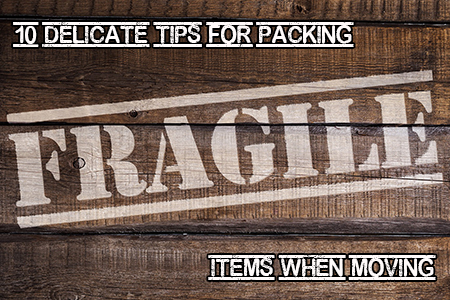 There are too many fragile and delicate items in each home – from chinaware, glassware and other breakable kitchen items, through electronic devices, framed artwork, mirrors and lamps, all the way to musical instruments.
There are too many fragile and delicate items in each home – from chinaware, glassware and other breakable kitchen items, through electronic devices, framed artwork, mirrors and lamps, all the way to musical instruments.
And when a house move creeps around the corner, the critical question of How to pack fragile items for moving takes center stage.
Packing fragile items for a move hides many risks for the easily-breakable things in question, and your mission is to identify those dangers and eliminate them through masterful packing skills.
Follow these 10 delicate tips for packing fragile items for moving:
1. INVENTORY your fragile items
Packing fragile items for moving will be a rather different packing experience than say, packing your clothes for a move. If you accidentally dropped a piece of clothing on the floor, it wouldn’t break. The worst thing that could happen to your clothes during a house move is to find some of them wrinkled when you start unpacking. And let’s face it – that’s something you can easily fix with an iron and bit of extra time.
The task of packing breakable items for moving can take a lot of time to finish and will require plenty of packing supplies to guarantee good results. In order to shorten the packing time and save on the packing expenses, you should inventory carefully all the fragile objects in your home – china dishes, glasses, electronic devices, picture frames, artwork pieces, musical instruments, and any other delicate items you own.
So, go through your fragile stuff and see if there are some items that won’t be worth the effort and cost of packing and moving. Don’t make packing any harder for yourself – if you haven’t used any easily breakable items in more than a year, then maybe you’d be better off selling them, gifting them or throwing them away.
How to make a home inventory when moving
2. Prepare the PACKING SUPPLIES
When it comes to packing breakables for a move, it should be clear that you’re going to need plenty of packing materials to get the job done well. The way you pack the fragile items in your home will be crucial for their survival throughout the house move, but what you pack those delicate items with will matter even more than you think.
First and foremost, you need to make sure that you’ve secured the right type of packing supplies for the job ahead:
- Cardboard boxes. It’s best to purchase the boxes new. Still, you can also get your moving boxes for free as long as they are strong, clean and dry.
- Packing paper. Soft wrapping paper will be the first line of defense for your breakable items, so make sure you’ve got enough of that useful packing material.
- Bubble wrap. There’s no doubt the bubble wrap will be the best protective material for your delicate and easily breakable things. Get as much bubble wrap as you possibly can.
As you know, to pack fragile items when moving, you’re going to need sturdy and clean cardboard boxes to transport them safely. Inspect all cardboard containers for any structural damage, then tape their bottoms with tape as an extra safety measure.
WHERE to get free moving boxes: Complete checklist
3. Use PACKING PAPER as an initial protective layer
You shouldn’t estimate the protective power and versatility of packing paper. In reality, when used smartly, the ink-free newsprint paper you’ve purchased will serve as an excellent initial protection for all of your breakable items found in your home.
In addition to wrapping, the soft packing paper can also be used to create a shock-absorbing layer inside the boxes and to fill up any empty spaces inside those cardboard containers as well.
-

When packing fragile items for a move, packing paper should always be your first line of defense.
PLACE some crumpled packing paper on the bottom of each box before filling it with fragile items. This way, you’ll get a good padding layer that will absorb potential vibrations or hits during the actual move. To save on your packing costs, you can also use plain newspapers for that too.
- WRAP fragile items always in soft packing paper first, then use pieces of tape to secure the bundles. The wrapping paper will protect the delicate surfaces from scratching and will cushion any unfavorable forces incidentally directed at them during transit.
- INSERT pieces of left-over packing paper into any remaining spaces inside the boxes to prevent the arranged fragile items from moving. Remember: any movements inside the cardboard containers may lead to damage to your breakables.
15 packing tips to help you pack like a pro
4. Apply BUBBLE WRAP to save your breakables
It’s fair to say that when packing fragile items for moving, it’ll be the bubble wrap that’ll do the most critical job of protecting your breakables.
There’s little doubt that the air-filled plastic film provides the best overall protection for your frail things. And it’s no secret either that you can never use enough bubble wrap to protect your valuables.
The thing is, sometimes it can be a bit confusing to determine when to use paper and when to use bubble wrap.
- REMEMBER to use bubble wrap as the second layer of protection, over the initial one made of packing paper. Despite its excellent protective qualities, when placed directly over delicate surfaces, bubble wrap may leave nasty marks or it can cause some furniture finishes to “sweat” – that is, to trap moisture, which can damage some of the fragile items you’re moving.
- WRAP super-delicate sections and elements with bubble wrap to keep them from getting damaged. Such extra vulnerable parts include the stems of your stemware glasses, glass figurines and segments made of glass such as doors, panels, shelves, etc.
- USE small pieces of tape to secure the bubble-wrapped bundles and keep them from unwrapping by themselves.
9 mistakes you must avoid when packing for a move
5. Use proper LABELING as an extra safety measure
You may think that labeling all the boxes that contain fragile items is kind of unnecessary because you won’t forget where you packed what. But even if you do have a great memory, it’s not only about remembering which cardboard boxes have fragile items inside them. More often, it’s about warning all the people who will handle those containers to be more careful when lifting, carrying, loading and unloading your easily breakable possessions.
Use a red marker (a black marker is also ok but the red color is supposed to grab the attention) to write FRAGILE and HANDLE WITH CARE on 2 sides of each packing box. Additionally, indicate the contents of the box and its destination room as well to simplify the unpacking process.
One good example of proper labeling when packing fragile items is WINE GLASSES, KITCHEN, EXTRA FRAGILE.
How to label your boxes like a professional packer
6. How to pack DISHES and GLASSES for moving
Soon after you’ve initiated the home packing process, don’t be surprised to find out that your kitchen is one of the hardest rooms to sort and pack due to the overwhelming number of items – small and big – found in it.
However, it’s the kitchen plates and glasses that will really test your packing skills. All in all, there are several important things to keep in mind when packing china plates and crystal glasses for a move.
-
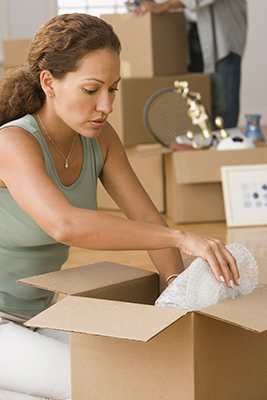
Make BUBBLE WRAP your most trusted assistant when packing fragile things.
USE dish boxes, whenever possible. Also known as dish packs, these cardboard boxes have thicker walls and provide a better protection for your breakable chinaware and glassware. If you only have standard cardboard boxes, make sure you re-tape their bottoms and use plenty of padding materials inside the containers.
- SET UP your kitchen table as a packing station and place the big stack of packing paper in the center.
- WRAP china plates in 2-3 pieces of packing paper as if wrapping a present. You can use paper plates between the breakables chinaware pieces for extra protection. Add bubble wrap on top for the more expensive or sentimentally valuable sets.
- ARRANGE the packed kitchen plates sideways in the boxes.
- FILL IN the glasses and cups with paper, then wrap each piece individually in wrapping paper. Secure all glass stems with pieces of bubble wrap for extra protection.
- ARRANGE the wrapped-up glasses and cups in pre-cushioned packing boxes.
How to pack dishes for a move; How to pack glasses for moving
7. How to pack ELECTRONICS for moving
Most electronic devices in your home – computers, monitors, printers, scanners, audio systems, home theater systems, gaming consoles, etc. – will be rather fragile and as such, will be susceptible to damage during a house move. And, having decided to pack up your things on your own, your mission should be to pack your electronics safely.
- BACK UP your digital data before packing up your electronic devices. Transfer the most important files to USB memory sticks, to an external hard drive or to an online storage service (cloud storage).
- PREPARE the boxes in which you will pack your electronics. For best results, you should use the original boxes that your devices came in when you purchased them. However, if you don’t keep them, you can still get the job done by using standard cardboard boxes with the right size and sufficient padding.
- TAKE PHOTOS of the way your electronic devices are wired up before disconnecting them. Label the cables properly, then use zip ties to organize them.
- POSITION cardboard cut-out pieces over sensitive screens or other super-fragile areas.
- WRAP your electronic devices with packing paper first, then use BUBBLE WRAP to protect their most delicate areas.
- USE soft protective blankets (furniture blankets) to cover some of your electronics for increased safety on the road.
How to pack fragile electronics for moving
8. How to pack PICTURES and MIRRORS for moving
Speaking of how to pack fragile things in the home, the framed art pieces scattered throughout your house or apartment definitely fall into that category. You can’t just take your framed photos, paintings, and mirrors off the walls and throw them into a random box, totally unprotected, exposed and vulnerable.
To pack fragile art – that is, to protect the framed artwork pieces and mirrors in your home, follow these tips for packing very fragile items for moving.
- PREPARE the right boxes to keep your framed photos and paintings protected during the move. If possible, purchase specialized picture moving boxes that are made of stronger and thicker cardboard. Also, picture boxes can be fitted snugly around framed items for extra protection.
- USE a large table as a packing station. Alternatively, you can pack your framed pieces directly on the floor as well.
- MAKE an X with a painter’s tape over the glass sections of your framed pictures, paintings, and mirrors. The X should be from corner to corner in a diagonal fashion and it should keep the glass pieces from going into the canvas or photo paper in case of breakage during the haul.
- POSITION cardboard cut-outs over the breakable glass sections, roughly the size of the frame. This way, you’ll get an even better level of protection for your framed items.
- PACK each framed item in large sheets of packing paper, then add bubble wrap as the final layer – especially for your more valuable artwork pieces.
- ADD sufficient padding to each picture packing box to make sure your photos, paintings, and mirrors won’t move inside throughout the move.
How to pack pictures and paintings
9. How to pack LAMPS for moving
You may not realize it right away, but many of the lamps in your home – table lamps and floor lamps – also fall into the category of fragile and breakable items. And you may have already decided to move most of them, so now the question of How to pack lamps for a move becomes more pressing than ever.
Lamps are really fragile but what makes their packing even more challenging is their odd and irregular shape. So, to pack lamps and lampshades for moving:
-
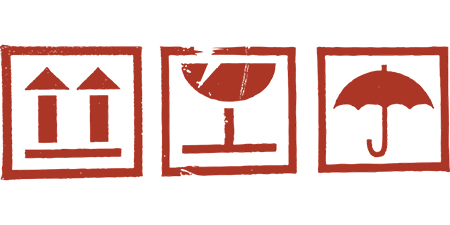
It’s important that you label correctly all boxes that contain fragile items.
USE the original boxes your lamps came in. Chances are you won’t keep them, so just take regular cardboard boxes with the right size and 1) reinforce their bottom outside with tape, and 2) place crumpled paper or pieces of bubble wrap on the bottom inside that will serve as effective cushions.
- DISASSEMBLE carefully your lamps. Depending on the exact model and design, you’ll need to figure out how to remove the lampshade, take out the harp (the U-shaped metal or plastic frame) and finally unscrew the light bulb. Sometimes, you may need to unscrew the socket in order to be able to take out the lampshade.
- SECURE the cord of the lamp to keep things safe. You may choose to keep it organized by using a cable tie or you may simply coil it around the base of the lamp.
- WRAP the lamp base, harp, and lampshade with a few sheets of packing paper, then cover it all up with bubble wrap for maximum protection.
- TRANSFER the base of the lamp, its harp and its lampshade into a pre-padded cardboard box, then fill up any gaps with paper (newsprint is ok).
- LABEL the box and mark it as FRAGILE.
10. How to pack MUSICAL INSTRUMENTS when moving
If you own any musical instruments in your home, then you must know how valuable they are. As a result, the last thing you’d want is to get a musical instrument damaged due to improper packing, followed by incorrect handling.
- PACK smaller musical instruments in hard cases and well-padded bags that have been designed specifically for them. If you don’t have a suitable instrument case, then it’s a good idea to purchase one from the nearest music shop. If that’s not possible, then use a strong cardboard box of the right size and then provide sufficient padding inside that cardboard container.
- LEAVE larger musical instruments like a piano or a Hammond organ to the care of professional piano movers. Moving a piano on your own is a very risky endeavor due to the huge size and staggering weight of pianos, even the smaller upright ones. Add the (sentimental) value of a piano and the high risk of accidents – both personal injuries and property damage, and you’ll soon be convinced of the need to hire professionals to get the job safely and quickly.
- MOVE your smaller instruments with you in your own vehicle, whenever possible.

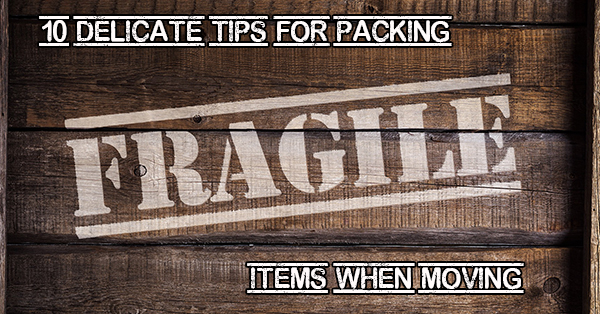





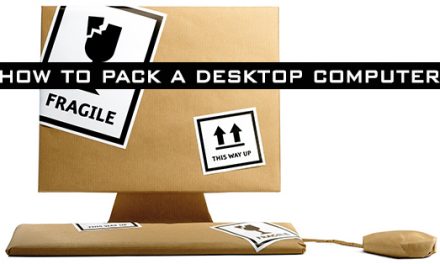
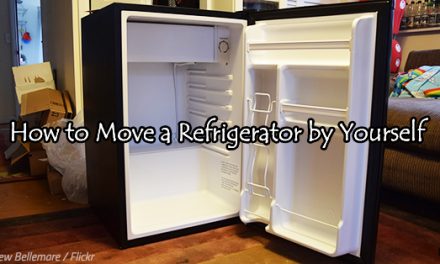

In packing fine China or plates and platters, I found that using paper plates as a spacer between each plate, along with a sheet of bubble wrap is helpful in preventing broken items.